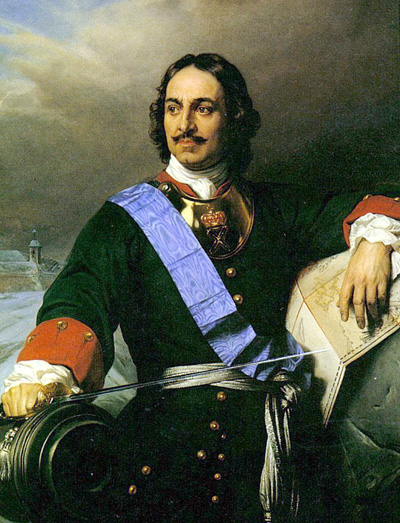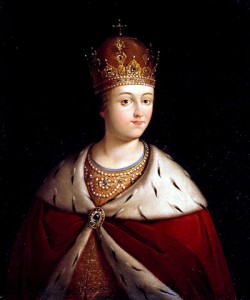One of the favourite stories told about Peter the Great is how he used to play soldiers and created his own “toy army” his poteshnye voiska. The story is often told to reveal Peter’s ambition and his ability to organise his peers but the creation of this toy army is firmly rooted in the political rivalry of the late 17th century.
The death of Tsar Fedor III on April 27, 1682, caused a political crisis in Russia. The Romanov family was split into two factions with the obvious heirs to the throne still in their minority, Streltsy troops were spurred into rebellion by rumors, spread by the Mikhailovsky faction opposed to Peter the Great’s accession to the throne. On May 17, Streltsy troops broke into the Kremlin and killed Peter’s two uncles Kirill and Ivan Naryshkin in front of the 10 year old prince. Although, Peter survived the attack, it had a deep impact on the tsarevich.
The political solution led to the regency of Sofia Alekseyevna during the minority of Peter the Great and Ivan V. It was this same year that Peter established his poteshnye voiska with which he played his war games.
Whether or not this was just a child wanting to play soldiers, the poteshnye voiska soon took on a much more serious nature. By 1683 the “troops” had not only enlisted Peter’s friends and servants, but had also recruited a serving soldier and the toy army was organised into a unit of 100. By the time Peter was 13 the toy army was recruiting soldiers and foreign officers to provide military expertise and specific military training to the so-called toy-army. Whether Peter intended it or not, he was creating a personal bodyguard and the basis of his later political authority.
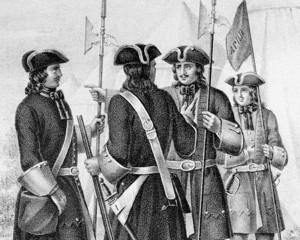 The establishment and ongoing development of Peter’s Toy Army is also important for the insights it gives into Peter the Great’s own military education and his approach to military affairs. His military training focused on taking children at a young age and developing their physical strength and agility at the ages of 9-12 by playing games and doing gymnastic exercises. The next step was to develop children’s bravery by adding an element of danger to the games by climbing cliffs and ravines, walking on rickety bridges, playing on logs and pretending to be bandits. These games also included guard duty and reconnaissance. The next stage in developing children’s military abilities included teaching them to use weapons – Peter the Great could fire a canon when he was 12. Other technical skills were also taught and a greater focus was placed on discipline, honour and comradeship. Patriotism and purpose were also taught by teaching selective moments of Russia’s history and the dangers and ambitions of neighbouring countries. From these classes children were taught a love of their fatherland and a love for the army.
The establishment and ongoing development of Peter’s Toy Army is also important for the insights it gives into Peter the Great’s own military education and his approach to military affairs. His military training focused on taking children at a young age and developing their physical strength and agility at the ages of 9-12 by playing games and doing gymnastic exercises. The next step was to develop children’s bravery by adding an element of danger to the games by climbing cliffs and ravines, walking on rickety bridges, playing on logs and pretending to be bandits. These games also included guard duty and reconnaissance. The next stage in developing children’s military abilities included teaching them to use weapons – Peter the Great could fire a canon when he was 12. Other technical skills were also taught and a greater focus was placed on discipline, honour and comradeship. Patriotism and purpose were also taught by teaching selective moments of Russia’s history and the dangers and ambitions of neighbouring countries. From these classes children were taught a love of their fatherland and a love for the army.
The effectiveness of this training was soon demonstrated. In the power struggle that occurred when the young tsar came into his majority, his potyshnye voiska gave him the core military support he needed to take over control of the royal court. When Sofia called on the Streltsy for support, most of them had already abandoned Moscow, preferring to live in Preobrazhensky village where the young tsar and his Toy Army was located – hence the name of the regiment.
In 1691 the puteshnye voiska located at Preobrazhenskoe and Semenovskoe villages were officially transferred as units in the Russian army and served with distinction during Peter the Great’s campaigns. In 1700 the unit was given the title leib gvardiya usually translated as “life guards” and were raised to the status of bodyguards to the tsar. In 1723 it was relocated to St. Petersburg where it was based until disbandment in 1917. Although the unit fought in most major conflicts, the unit played a critical role in Russia’s domestic politics as bodyguard and kingmaker.
After the accession of the infant Ivan VI in 1740, the empire faced a number of problems, including a struggling economy. Elizaveta was the eldest daughter of Peter the Great and Catherine I who were secretly wed in 1707. Elizaveta, being born in 1709 before the wedding between Peter the Great and Catherine I was formally announced was seen as illegitimate and forfeited her right to the throne. However, being the daughter of Peter the Great, she was popular amongst the soldiery and took pains to cultivate the guards units, in particularly the Preobrazhensky Regiment. On November 25, 1741, she arrived at the regimental headquarters and demanded their support. The unit arrested their own commander and stormed the Winter Palace, removing the infant tsar. Elizaveta went on to become one of Russia’s best loved rulers. Before coming to power she promised never to execute a single person, a promise that she kept even after the coup and throughout her 21 year rule.
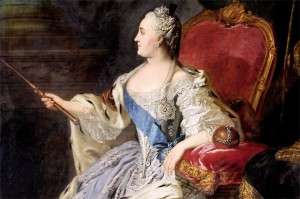
Catherine the Great was a German princess and came to power in a palace coup that removed her husband, Peter III. She went on to become the model of an Enlightenment princess – although she had strict views on serfdom and the royal prerogative.
In 1762 the unit again was involved in a power struggle. Peter III, having recently come to the throne pursued a foreign policy which earned him the ire of the army, while within his household relations were strained. He openly threatened to divorce Catherine so he could marry his favourite Elizaveta Vorontsova. Lead conspirators in the coup that overthrew Peter III included Preobrazhensky Guards officers, including 27 year old Grigory Orlov who was at that time Catherine’s lover. During the coup a 22 year old cavalry guard sergeant, Wachtmeister Potomkin, came to the notice of Catherine and later became her lover and eventually minister of war.
While the Preobrazhensky regiment was granted a high status within the Russian Imperial army – members of the unit were considered to be two ranks higher than those of other units – criticism was raised that they knew little of real soldiering. Field Marshal Alexander Suvorov who served his cadetship in the Semenovsky Guards in the 1740s, later complained that the only soldiering guards regiments knew was parade drill.
Under Catherine the Great, along with their enhanced status, the Preobrazhensky regiment took over other roles associated with the empress’ safety – carrying out arrests of suspected traitors and other political criminals on behalf of the Secret Expedition, an early precursor to the political police that were established in the 19th century.
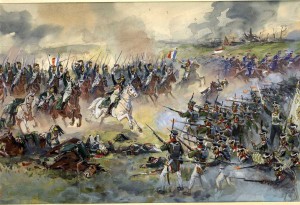
Battle of Borodino 1812 was a Pyrrhic victory for Napoleon and was followed shortly after by his withdrawal from Russia with the destruction of his Grande Armee.
The regiment fought with distinction in the Napoleonic Wars and continued to enjoy its honoured position within the Russian court. The unit had the highest number of noblemen of any in the Russian army and provided training to the tsar’s family where the crown prince could acquire military knowledge. This continued link with royalty meant that the Preobrazhensky regiment was involved in suppressing the Decembrist uprising of 1825, although notably Colonel S. P. Trubetskoy, elected dictator of the Decembrists, was serving with the regiment at the time.
The unit fought in major wars throughout the 19th century – the fence surrounding the Preobrazhensky Cathedral just off Liteiny Prospekt is made from Turkish guns seized by the unit during the 1825-9 Russo-Turkish War. However, the last days of the regiment are intimately connected with the fall of the imperial family.
In 1905, detachments of the Preobrazhensky regiment fired on unarmed protesters on Nevsky prospekt, which led to significant disenchantment with the regime. In March 1917 Tsar Nicholas II abdicated after even the Preobrazhensky regiment refused to follow orders to attempt to suppress protests associated with the February Revolution. Their commander Alexander Pavlovich Kutepov disbanded the unit in 1918 and became a leader of anti-Bolshevik forces during the ensuing civil war.
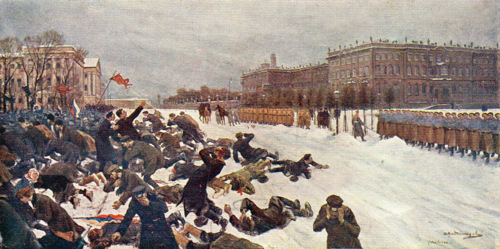
Bloody Sunday 1905. Protesters are fired on by the tsar’s guards
Established by Russia’s first emperor, the Preobrazhensky regiment’s fate was linked inexorably with the fate of the royal family, playing bodyguard, kingmaker and assassin. It is appropriate therefore that with the execution of the imperial family, the unit was also disbanded. In a curious historical footnote, President Vladimir Putin re-established the Preobrazhensky Regiment as the 154th Preobrazhensky Independent Commandant’s Regiment in 2013.
This is an extended article of one which was first published by The St. Petersburg Times on 7 May 2014.
Be sure to like Intrepid Adventure on Facebook and check out Peter Campbell’s latest books on Amazon.com.
Copyright © Peter Campbell 2014, www.intrepid-adventure.com
